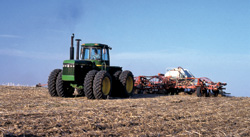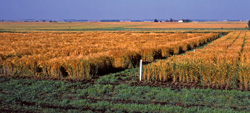
Features
Agronomy
Fertility and Nutrients
Understanding soil test recommendations: Part I
Philosophy varies between laboratories.
November 28, 2007 By Bruce Barker
For growers who have ever split a soil sample and sent it to several different
laboratories, it is understandable how different methodologies and philosophies
can impact fertility programs. The analysis is not necessarily wrong, but the
recommendations for a field might be.
"Different labs equal different results. A lab, for example, might take
a soil test calibration from an area in the US and apply it to western Canada,
which can lead to inaccurate recommendations," says Rigas Karamanos, manager
of agronomy at Westco Fertilizer in Calgary, Alberta.
 |
| Fertilizer recommendations are more predictable in the Dark Brown soil zone than on Black soils. Photos Courtesy Of Bruce Barker. |
To underscore the differences, Adrian Johnston, with the International Plant
Nutrition Institute (formerly PPI/PPIC) at Saskatoon, Saskatchewan, refers to
a Westco experiment where a soil sample was split and sent to six different
laboratories for analysis. Fertilizer recommendations for nitrogen (N), phosphorus
(P), potassium (K), sulphur (S) and micronutrients were obtained. Also obtained
were results for a Virtual Soil Test (VST), a method of estimating crop nutrient
requirements using previous years' soil test reports. Subsequently, actual yield
and net return were calculated.
While the fertilizer recommendations varied dramatically, the difference in
actual yield only varied by five bushels per acre for spring wheat. However,
the difference in net return was more than $24 per acre.
Of particular note in the trial was that laboratories five and six were located
in an area with much higher production than Irricana. While these laboratories
had slightly higher target yields, their N fertilizer recommendation was much
higher because they do not consider the ability of soil to store N over the
winter, something common in western Canada. As a result, they recommended more
N, generally based on the complete demand of the crop yield goal. The bulk of
the crop response was met with 60 to 70 pounds N per acre, and there was no
response to K, S or micronutrients applied.
"In this case, sending a soil sample outside the region for analysis would
have cost the grower an extra $24 per acre to grow the crop," says Johnston.
Knowing where a soil test laboratory is located is only the start of the recommendation
process, though. The laboratories may also have varying philosophies when it
comes to making recommendations.
Sufficiency approach to recommendations
The sufficiency approach to fertilizer recommendations uses field research that
evaluates crop response to soil nutrient content. Research identifies soil test
levels where crop response is no longer expected from nutrient addition. Below
this soil test level, the field trial results indicate that some response by
the crop is expected and the lower the soil test level, the higher the probability
of a response. This method of assessing crop response is used with all nutrients
Johnston says the sufficiency approach fertilizes only when there is a good
chance that a profitable yield response can be obtained. This means the soil
test levels are usually always maintained in the responsive range.
"However, most fertilizer recommendations are based on a $1.00 return
for each $1.00 invested in fertilizer, but growers may want a better return
so they can reduce their risk, especially with low value crops," says Johnston.
"Using a 1.25:1.00 return provides more risk aversion, by recommending
a N rate that is less than when a 1:1 ratio is used."
| Table 1. Impact of fertilizer recommendations on spring wheat yield at Irricana, Alberta. |
||||
| Laboratory |
Fertilizer recommendation |
Target yield (bu/ac) |
Actual yield (bu/ac) |
Net return ($/ac) |
| 1 | 55-20-0-0 | 43 | 51.7 | 216.11 |
| 2 | 60-20-19-5 | 32 | 52.9 | 216.52 |
| 3 | 60-23-0-4 | 40 | 53.4 | 217.64 |
| 4 | 65-20-0-0 | 33 | 54.4 | 224.70 |
| 5 | 110-20-10-14 + 3Cu | 55 | 55.7 | 210.77 |
| 6 | 129-24-25-0 + 1Cu + 1B | 55 | 55.9 | 214.00 |
| VST | 78-22-15-7 | 45 | 56.7 | 235.33 |
| Source: Westco Fertilizers. | ||||
Karamanos says to use the sufficiency approach, the extraction method used
by a laboratory must be appropriate for the area, and the data collected must
be calibrated to field tests in the local area. Methods of application are important
also, especially for P and K, where broadcast rates can be significantly higher
than banded or seed-placed rates.
"If the soil test results aren't calibrated to the local area conditions,
the recommendations won't be backed up by field performance," explains
Karamanos. "You should only use recommendations from labs where the methodology
and interpretation are based on local results."
Build and maintain approach not commonly used
The 'build and maintain' approach to fertilizer application is based on applying
nutrients in excess of crop removal as a means of increasing the soil test level
to the non-responsive range. Johnston says this approach removes any potential
of a nutrient deficiency as a yield limiting factor. Once at this soil test
level, nutrients are applied based on estimated crop removal so that the soil
nutrient level is maintained.
This approach is only suitable for less mobile nutrients like P and K, since
N and S have potential for losses due to leaching and denitrification. Unlike
the sufficiency approach, which is based on the plant response, the build and
maintain approach is based on the soil test level.
One place where this approach may have some validity is on eroded knolls and
hilltops where fertility is often very poor. While the amount of P and K required
to build varies by soil type, generally the ranges are six to 14lb/ac P2O5
to increase soil P by one pound per acre. Manure application based on N requirements
of the crop often result in an increase in soil test P and K, and would be suitable
for building poor P and K fertility on eroded knolls.
Blending science and field experience
Using the sufficiency model, many laboratories also account for a number of
other less quantifiable factors that influence nutrient response, such as mineralizable
N estimates, fertilizer use efficiency and the value of soil residual nutrients.
Johnston says that soil mineralizable N has become an issue of interest in recent
years, largely because of the lack of crop response that growers observe when
N fertilizer is applied.
Past research in Saskatchewan has shown that soil mineralized N in Brown and
Dark Brown soils is fairly easy to predict, but that on Black soils, it is next
to impossible. The reason is that a larger organic matter pool can supply mineralized
N to the crop under warm, moist environmental conditions.
Generally, there are 1000 pounds of N per acre for every one percent organic
matter, but only one percent of that is available in any given year. If a soil
has five percent organic matter, it could have 50 pounds of N per acre available
from mineralized N. However, just because the potentially mineralizable N is
there in the soil, it does not mean it will mineralize and become plant available.
 |
| Fertilizer recommendations can vary due to differences in philosophy. |
As a result, Johnston says that growers in the Black soil zone are less likely
to be satisfied with the fertilizer N recommendations made by soil test laboratories.
On Black soils, excessive N fertilizer recommendations are often the most common
complaint, but Johnston cautions growers to cut back on rates or they risk poor
yields in years when conditions do not favour mineralized N. On the other side
of the coin, high organic matter soils can deliver high yields in years of above
normal moisture and warm growing conditions.
"Most fields with well managed fertility can sustain high yield years
with only a small drop of about one-quarter percentage in protein. The problem
comes on low organic matter soils with little mineralizable N. Those are the
soils where growers should pay particular attention to nitrogen fertility,"
he explains.
When setting up a fertility program, after considering the appropriateness
of the soil test laboratories and their philosophies, Karamanos and Johnston
suggest growers ask themselves and their agronomists several questions, especially
in this era of high fertilizer prices. Does the economic data represent yields
similar to a grower's particular farm? Will their agronomic package including
variety, seeding rate, pest management and so on, be adequate? What type of
return does the grower want with his fertilizer? How big of an impact does N
rate have on crop quality and yield?
"Understand where you are on the yield curve. If you are on the lower
end of fertility, then cutting N will have a larger effect on yield than if
you used traditionally higher rates," says Johnston. "That will help
to determine your risk when determining fertility programs."
Look for Part II of this story in the
April issue: soil test methodologies will be featured.